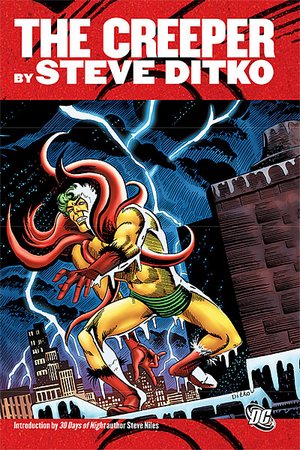Comics /
Comic Reviews /
DC Comics
The Creeper by Steve Ditko
By Leroy Douresseaux
June 15, 2010 - 08:18
 |
| The Creeper by Steve Ditko cover image |
Some readers and fans have spoken of the realistic nature of the stories in Marvel Comics or the realism Stan Lee injected into Marvel Comics. Even while including a sense of verisimilitude, DC Comics has traditionally embraced the fantastic, the bizarre, the strange, the unusual, and the just plain weird throughout its history, even going back to the three publishers that would merge to form DC Comics. Such an outlook laid the foundation for DC to have the vision (or fortune, if you will) to publish such titles as
Swamp Thing (both the Wein-Wrightson and Alan Moore versions) and
The Sandman.
One unusual DC Comics character is The Creeper, a late 1960s creation of Steve Ditko, the driving force behind
The Amazing Spider-Man and
Doctor Strange. From 1968 to 1979, The Creeper appeared in 16 stories drawn and often written by Ditko. DC Comics recently collected these stories – one of them being reproduced for the general public for the first time – in a hardcover collection entitled, The Creeper by Steve Ditko.
The Creeper is like a blending of Spider-Man, Doctor Strange, and another Ditko creation, The Question (for Charlton Comics). The Creeper’s civilian identity is Jack Ryder, who starts off as a reporter and program host for WHAM-TV of Gotham City, before being fired. Ryder takes a job working security and doing investigations for the station, a job he would later also do for another Gotham broadcaster, the Cosmic Broadcasting Network. During his first investigative assignment, Ryder is stabbed while trying to save a scientist named Professor Yatz. Yatz inserts the weird science invention that both saves Ryder and transforms him into The Creeper inside Ryder’s open stab wound.
The Creeper wears a garish yellow body suit in which the briefs or trunks are in a green and black-striped pattern. His hair is green, and his face is yellow. His cape is a wild sheepskin rug died red, which matches his red gloves and boots, and The Creeper’s adventures are as wild and crazy as his getup.
The Creeper, like many of characters that Steve Ditko visualizes, from Spider-Man to Speedball, literally bounces off the walls and flies about like a mad acrobat who doesn’t care that he hasn’t got a net under him. Ryder is a man who sees the world as black and white, good and evil, so he shows little or no sympathy for criminals, and, as The Creeper, he is even more merciless. The Creeper faces off against low-rent, oddball gangsters; cold-blooded, costumed murderers (Angel Deviln, The Menace), assorted tragi-freaks and mental cases (Proteus, Dr. Storme), and villains who apparently constructed their costumes out of stuff they found at the local dollar store (The Firefly, The Monster)
The Creeper by Steve Ditko features well-defined reconstruction of the colors and art (by Digikore Studios Limited), so it is almost like getting to experience The Creeper’s weird adventures in HD. The best way to enjoy these stories is too see the sharp colors and clear lettering, which makes it easier to understand these weird stories. The Creeper stories from the late-60s comic book series, Beware the Creeper, are darker and more surreal and feature sudden brutal violence.
The stories that appeared as backups in the late 70s (in
World’s Finest Comics) are lighter, even playful. Calling these short pieces “kooky” just doesn’t quite describe them. They are odd – like World War II era superhero comics, but the environments (sets, backgrounds, backdrops, etc.) and wardrobes (clothes, hairdos, costumes, etc.) seem stuck in the 60s.
As a collection of a distinctive creator’s work on one of his distinctive creations,
The Creeper by Steve Ditko is quite nice. It’s a cool slice of DC Comics history and a nice example of the publisher’s predilection for the fantastic, even when it results in an uncanny child. The medium is all the better for DC’s adventurous side, and The Creeper is proof of that. The Creeper comics are not necessarily great works, but it is great that they exist.
Introduction by Steve Niles (author of 30 Days of Night).
The comics reprinted herein include
Showcase #73 (1968);
Beware the Creeper #1-5 (1968-69);
1st Issue Special #7 (1975);
World’s Finest Comics #249-255 (1978-79); and
Cancelled Comic Cavalcade #2 (1978)
Last Updated: January 17, 2025 - 08:20
